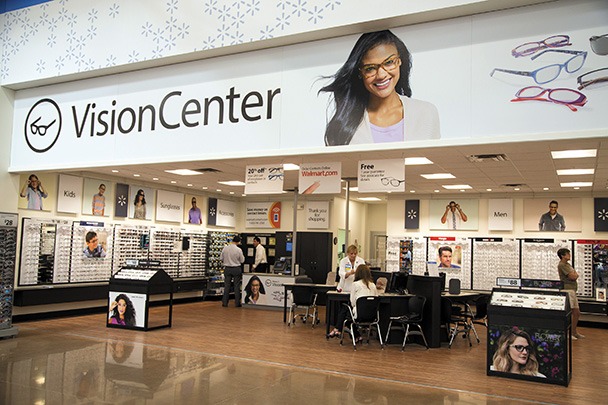Walmart U.S. slows on health and wellness programs
by November 7, 2016 12:00 am 1,558 views

Walmart U.S. in past years aimed at leading change in the health and wellness arena, from instituting $4 generic prescriptions in 2007 to offering immunizations in-store in 2012 to opening its own health clinics in 18 stores staffed by a partnership with QuadMed in 2014.
The pace of news, however, from the retailer on health and wellness initiatives has slowed.
In the fall of 2015, Walmart U.S. held its first national health fair, dubbed Walmart Wellness Day, in more than 4,400 stores, and the event was repeated this year. The retailer said it is still working through the Oct. 15, 2016, health fair findings and did not have complete results. Walmart said initial results indicate similar numbers to those reported last year.
The 2015 Health Fair results included:
• 280,000 screenings done onsite for blood pressure, glucose and vision;
• 52,000 immunizations given; and
• 3,000 customers were advised of blood glucose concerns.
When asked what was new on the health and wellness agenda, Walmart said simply it continues commitments to make healthcare and healthier food more affordable and accessible. The retailer also stressed its commitment to preventative care and overall well-being across its assortment of products. A product example cited by the retailer is an exclusive line of blood glucose meters, insulin and test strips by Reli-On. Walmart said the average annual savings for a diabetic using the Reli-On products is more than $700 when they test blood sugar twice a day.
Walmart said it also continues to work with DirectHealth to help customers with Healthcare marketplace enrollments. The retailer said the number of enrollments doubled this year over last through its DirectHeath partner program.
Health and Wellness was 11% of the retailer’s total U.S. sales in fiscal 2016 — worth $32.82 billion. Walmart’s health and wellness sales rose 3.5% or $1.14 billion from the prior year.
Executive Turnover
Former Wal-Mart executive Dr. John Agwunobi spoke often about the company’s focus on healthcare during his time with the retailer from 2007 to 2015. But after he left the job, the retailer has seen turnover in health and wellness executives at Walmart and less public discussion about new initiatives related.
Dr. Agwunobi left Walmart in early 2014 and was replaced by Labeed Diab, who at the time had been leading Walmart’s Midwest Division as a senior vice president. Diab previously worked in pharmacy management with CVS Caremark and Rite Aid before joining Walmart in 2009. Diab reported to then-Chief Merchandising Officer Duncan McNaughton.
In December 2015, Walmart replaced Diab with George Riedl as senior vice president of Walmart health and wellness. Riedl reported to Michelle Gloeckler, who took over that division with McNaughton’s departure. Riedl spent 27 years at Walgreens as chief merchant and is a pharmacist by trade. He now reports to Scott Huff, who took over the health and wellness oversight following Gloeckler’s exit in August. Huff has since been promoted to executive vice president of consumables and health and wellness. He has been with Walmart for 22 years, working his way up the merchant ladder from buyer to merchandizing manager into senior management roles.
Gloeckler said in June at the Emerging Trends in Retail Conference in Rogers that limited capital, even for a company as large as Walmart, was a growth barrier for some areas of the business. She said there is fierce competition for the capital to fund new programs because store updates and e-commerce expansion can keep the pool drained. She said departments and categories must compete for capital every year. Gloeckler, who was passionate about Walmart’s health and wellness program, said she expected to see more emphasis placed on home care.
Although asked, Walmart U.S. did not make Huff or Riedl available for interview to further discuss the retailer’s focus on health and wellness initiatives.
The consensus among supplier consultants representing multiple health and wellness products inside Walmart U.S. is that it’s harder for small suppliers to get noticed in what has become a crowded category.
Some suppliers haven’t participated in recent health fairs to provide information and samples to customers because the fee for sponsorship slots — $70,000 — was cost prohibitive. While two of the suppliers said they have tremendous support from their buyers, it’s still a challenging category in which to do business with Walmart U.S.
Care Clinics
A year ago, Gloeckler provided an update on the in-store Care Clinics, but no update was given this year.
Walmart did say it still operates 18 clinics, with no new openings over the last year. The retailer reiterated that the Walmart Care Clinic is a primary healthcare clinic staffed by licensed nurse practitioners who offer a wide range of services.
The clinics are located in Texas, South Carolina and Georgia. The most recent clinic opening was Nov. 11, 2015. A year ago Walmart said repeat customer visits outnumbered new customer visits indicating community acceptance. The clinics allow Walmart employees covered under their medical plan to visit for a $4 co-pay. The general public can use the clinic for a $40 co-pay. Nationwide, a typical doctor visit with no lab work ranges between $190 and $250.
Walmart also said employee usage of the clinics was about 22%, with the majority of patients being from within the community and Walmart customers. The Care Clinic program was begun under the leadership of then Walmart U.S. CEO Bill Simon, who was also credited with the $4 prescriptions. Simon departed the company in July 2014 shortly before Wal-Mart Stores CEO Doug McMillon named Greg Foran as the next CEO of Walmart U.S.
Walmart has placed health screening kiosks in more than 2,200 of its stores. The kiosks check blood pressure, measure body mass index and perform vision screening.
